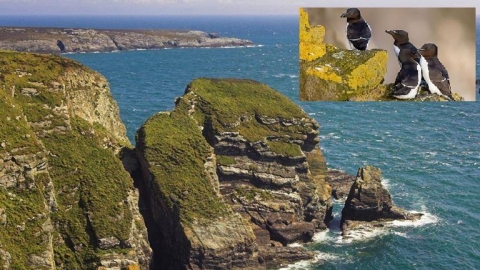Fears of threat to Irish Sea bird life from new energy scheme

News from the Celtic League:
The Celtic League have drawn attention to possible dangers posed to Irish Sea bird life by a proposed new seabed energy scheme off the Welsh coast. As has been pointed out, not least by Plaid Cymru-Party of Wales, even though Wales has a thousand miles of coastline, five million acres of land and a number of untapped natural resources, it produces less renewable energy than elsewhere in the UK. However, this being the case, there still has to be a proper assessment of the impact upon the environment and wildlife of each new scheme. The concerns raised by the RSPB and highlighted in the Celtic League article have to be taken into account. If the seabed energy scheme off South Stack in Anglesey goes ahead in its present form the RSPB point out that on the amount of energy produced: "we estimate this is only 1% of the electricity Wales is likely to use in 2035". The Celtic League article can be read below:
"IRISH SEA SCHEME COULD DEVASTATE BIRD LIFE FEAR
A planned seabed energy scheme off South Stack in Anglesey could devastate Irish Sea marine bird life a leading wildlife charity believes. The Morlais energy project covering a sea area of thirty five square miles about forty five miles south of Mann
The project developer is Menter Môn described as ‘a social enterprise which works across north Wales to deliver a range of regeneration, environmental and cultural projects for the benefit of local communities’ On the Morlais energy site they have a video presentation in Welsh and English which outlines the project they say will ‘add value’ to the seabed.
Link:
https://www.morlaisenergy.com/
However the RSPB have concerns they say:
“South Stack nature reserve is a much visited and iconic coastal habitat. It is part of the Holy Island Coast Site of Special Scientific Interest, in which thousands of seabirds make their home on the cliffs each summer - puffins, kittiwakes, fulmars, over 10,000 guillemots and 1,300 razorbills. For over 180,000 people every summer, the sounds of the seabirds on the breeze are part of their memorable visit to South Stack.
“Menter Môn has proposed developing a novel technology in a sensitive ecosystem off the Anglesey coast. It’s a largescale development of turbines, some fixed to the seabed and others floating on the surface. If the scheme, as proposed, is fully developed, up to 240MW capacity of renewable energy might be installed. This sounds like a lot, but we estimate this is only 1% of the electricity Wales is likely to use in 2035.
“We welcome that Menter Môn has undertaken surveys to build a picture of the wildlife in the area. However, because the novel technology is untested, they have used modelling to predict the likely impacts on wildlife. The assessment includes a range of estimates on the impacts on birds; an example (which is not the worst case scenario) is that 60% of the guillemots and 98% of the razorbills at South Stack would be lost as a result of colliding with turbines. The cliffs at South Stack could become silent as the seabirds disappear.”
Link to full item:
https://community.rspb.org.uk/…/south-stack-and-why-we-are-…
Related link RSPB Cymru:
https://community.rspb.org.uk/…/sou…/posts/update-on-morlais
News report today BBC Cymru (Welsh language) and BBC Wales:
https://www.bbc.co.uk/cymrufyw/53729338
https://www.bbc.co.uk/news/uk-wales-53731253
Image: South Stack cliffs - Inset: Razorbills
Bernard Moffatt
Celtic League"






